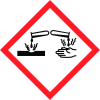S-6889F-N
AccuStandard, Inc
Revision date : 2016-03-03




Note: Ingredients listed on restricted chemical lists
EC/CAS
211-670-0/683-18-1
Name of the chemical
Dibutyltin dichloride (DBTC)
Concentration
TWA
General Information
Revision date
2016-03-03
Product name
S-6889F-N
CAS No.
683-18-1
Supplier name
AccuStandard, Inc
Emergency telephone
AccuStandard, Inc
Icons in SDS
Company Information
Company name
AccuStandard, Inc
E-mail address of the competent person responsible for the Safety Data Sheet
edocs@accustandard.com
GHS Information
Signal word
Danger
Hazard Codes
Hazard statements (CLP)
H301, H312, H314, H317, H318, H330, H335, H341, H360, H370
Hazard statements
Code
Statements
H301
Toxic if swallowed
H312
Harmful in contact with skin
H314
Causes severe skin burns and eye damage
H317
May cause an allergic skin reaction
H318
Causes serious eye damage
H330
Fatal if inhaled
H335
May cause respiratory irritation
H341
Suspected of causing genetic defects
H360
May damage fertility or the unborn child
H370
Causes damage to organs
Precautionary statements
Code
Statements
P202
Do not handle until all safety precautions have been read and understood.
P260
Do not breathe dust/fume/gas/mist/vapors/spray.
P262
Do not get in eyes, on skin, or on clothing.
P264
Wash ... thoroughly after handling.
P284
[In case of inadequate ventilation] Wear respiratory protection.
P331
Do NOT induce vomiting.
P338
Remove contact lenses, if present and easy to do. Continue rinsing.
P340
Remove victim to fresh air and keep at rest in a position comfortable for breathing.
P360
Rinse immediately contaminated clothing and skin with plenty of water before removing clothes.
P404
Store in a closed container.
Section 2
SECTION 2: Hazards identification
2.2 Label elements
0 3 HEALTH 3 1 0 FLAMMABILITY 1 - continued Precautionary Codes: P202 - This product should only by used by persons trained in the safe handling of hazardous chemicals. P260 - Do not breathe vapor. P262 - Do not get in eyes, on skin or clothing. P264 - Wash thoroughly after handling. Do not take internally. Eye wash and safety equipment should be readily available. P284 - Respiratory Protection: If workplace exposure limit(s) of product or any component is exceeded (see TLV/PEL), or a risk assessment shows air-purifying respirators are appropriate, use of a NIOSH/MSHA approved air supplied respirator is advised. Use a full-face respirator with multi-purpose combination (US) or type ABEK (EN14387) respirator cartridges in absence of proper environmental control. Always use respirators and components tested and approved under appropriate government standards such as NIOSH (US) or CEN (EU). Engineering and/or administrative controls should be implemented to reduce exposure. P331 - Ingestion: Do NOT induce vomiting. Call a physician or poison control center immediately. Give victim a glass of water a little at a time. Never give anything by mouth to an unconscious person. If vomiting occurs spontaneously, lower head below waist to prevent fluid from entering the lungs. P338 - Eye contact: Immediately flush with plenty of water. After initial flushing, remove and contact lenses and continue flushing for at least 15 minutes. Assure adequate flushing by separating the eyelids with fingers. P340 - Inhalation: Remove to fresh air. If not breathing, give artificial respiration. If breathing is difficult, give oxygen. Get medical attention. P360 - Skin contact: Immediately flush skin with plenty amounts of water for at least 15 minutes while removing contaminated clothing and shoes. Get medical attention immediately. Thoroughly wash (or discard) clothing and shoes before reuse. P404 - Store in a tightly closed container.
Signal word
Danger
Hazard statements
H301 - Toxic if swallowed. (Acute toxicity, oral, category 3) H312 - Harmful if absorbed through skin. (Acute toxicity, dermal, category 4) H314 - Causes skin burns. (Skin corrosion/irritation, category 1) H317 - May cause skin sensitization. (Sensitization, skin, category 1) H318 - Causes serious eye damage. (Eye damage/irritation, category 1) H330 - May be fatal if inhaled. (Acute toxicity, inhalation, category 2) H335 - May be irritating to mucous membrane and upper respiratory system. (Specific target organ toxicity, single exposure; Respiratory tract irritation, category 3) H341 - Suspected of causing genetic defects. (Germ cell mutagenicity, category 2) H360 - Reproductive hazard. (Reproductive toxicity, category 1) H370 - Causes damage to organs. (Specific target organ toxicity, single exposure, category 1) - continued
2.3 Other hazards
2.2.1 - Symptom of Exposure Health/Environment May cause skin sensitization. (Sensitization, skin, category 1) Reproductive hazard. (Reproductive toxicity, category 1) Suspected of causing genetic defects. (Germ cell mutagenicity, category 2) Causes damage to organs. (Specific target organ toxicity, single exposure, category 1)
Potential health effects
Causes serious eye damage. (Eye damage/irritation, category 1) Causes skin burns. (Skin corrosion/irritation, category 1) Harmful if absorbed through skin. (Acute toxicity, dermal, category 4) May be irritating to mucous membrane and upper respiratory system. (Specific target organ toxicity, single exposure; Respiratory tract irritation, category 3) May be fatal if inhaled. (Acute toxicity, inhalation, category 2) Toxic if swallowed. (Acute toxicity, oral, category 3) 2.2.3 - Routes of Entry Inhalation, ingestion or skin contact. 2.2.4 - Carcinogenicity This product is or contains a component that is not listed (ACGIH, IARC, NTP, OSHA) as a cancer causing agent.

